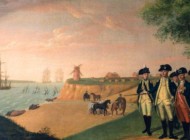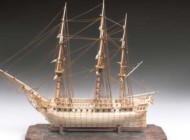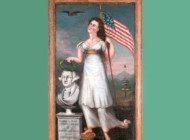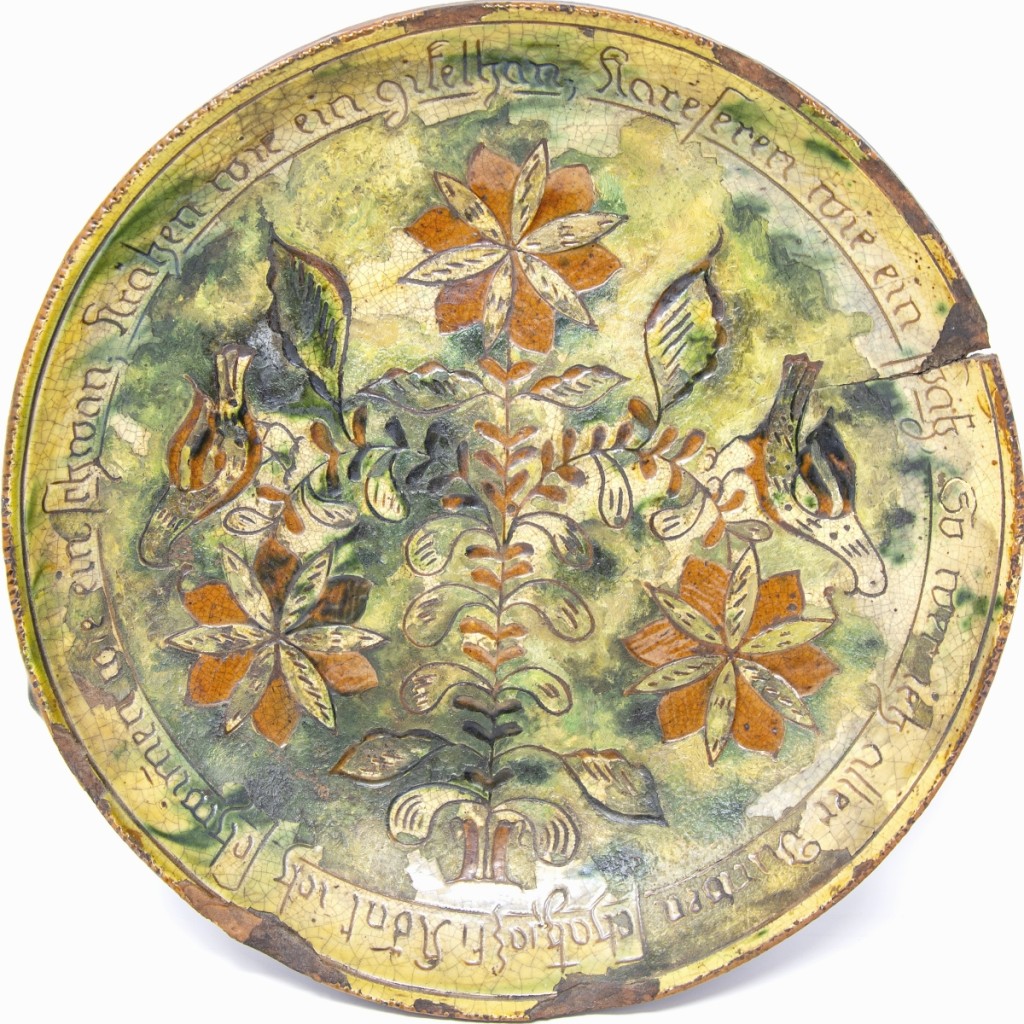
Sgraffito plate, Samuel Troxel (1803-1870), Upper Hanover Township, Montgomery County, Pennsylvania. Collection of Bradley and Deanne Hamilton.
By Justin Thomas; Unless noted otherwise, photographs by Cynthia Kirby-Reedy
LANCASTER, PENN. — An outstanding pottery exhibit debuted in March of 2019 in the visitor center at the Landis Valley Village and Farm Museum in Lancaster, Penn., “Thrown, Fired and Glazed: The Redware Tradition From Pennsylvania and Beyond.” This is a two-year exhibit, made possible by a generous grant from the Richard C. Von Hess Foundation, an organization created to help fund Susanna Wright’s (1697-1784) Ferry Mansion Museum, built in Columbia, Lancaster County, Penn., in 1738, as well to further support art education and other charitable purposes.
The Landis Valley Museum is one of the most unique places to visit in Lancaster County, located on 100 acres of farmland at the site of a former rural crossroads village. The museum was founded by Henry Landis (1865-1955) and George Landis (1867-1954) in 1925. The brothers were active collectors in a wide range of antiques, including Conestoga wagons, furniture, farm equipment, pottery and other local decorative arts, which were put on display. The museum was incorporated in 1941, and today it is operated by the Pennsylvania Historical and Museum Commission.
The first-half of the exhibit was installed in 2019, with the second-half more recently debuted, opening to the public on Sunday March 8 and running until June 30, 2021. Like many museums across the country, the Landis Valley Museum was temporarily closed due to the COVID-19 outbreak and has recently opened its doors again. More than 200 pieces of pottery are included as part of the new installation, largely symbolizing the ideas of function, form and decoration, assembled by a group of people including the museum’s curator, Jennifer Royer, and guest curator, John Kolar.
The new exhibit is drawn from private collections and the Landis Valley Museum’s collection, as well as other institutions, such as Winterthur, the Barnes Foundation, the Museum of the Shenandoah Valley, the Mercer Museum and the State Museum of Pennsylvania, among others. The exhibit highlights the wares made in southeastern Pennsylvania in the Eighteenth and Nineteenth Century, but there are also wares that stretch production throughout the American eastern seaboard, such as red earthenware made as far north as the Benjamin Dodge (1774-1838) Pottery in Portland, Maine, to the vibrant slip-decorated pottery manufactured in the Shenandoah Valley in Virginia in the Nineteenth Century. Many of the exceptional objects have never been displayed publicly and are extremely rare to see today, representing pottery manufactured in both urban industry settings and by small country potters, some of whom were farmers, supplementing their yearly income with pottery sales.
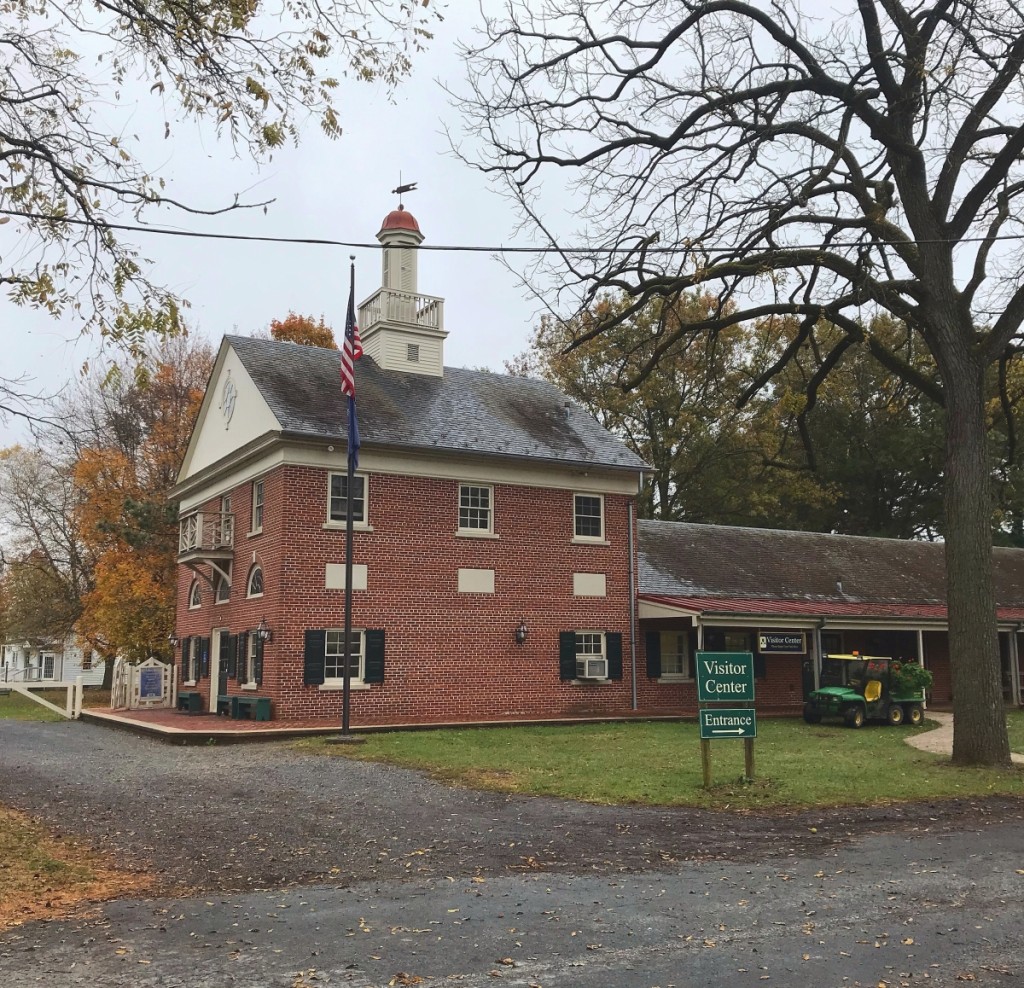
The visitors center at the Landis Valley Museum in Lancaster, Penn. This is where the exhibit, “Thrown, Fired and Glazed: The Redware Tradition From Pennsylvania and Beyond” is displayed.
The clay was typically dug in the area where the pottery operated. It was less common for this type of clay to be imported, unlike some American stoneware manufacturers who used a different type of high-fired clay that was not easily accessible everywhere in the country. Some American potters also imported kaolin, used in the process to manufacture some slipware. But based on the amount of slipware produced in Pennsylvania in the Eighteenth and Nineteenth Century, potters must have had access to multiple kaolin mines.
Red earthenware or redware, as it is referred to by American collectors, was brought to America in the Seventeenth Century, when English, Dutch and German immigrant potters settled in areas like Charlestown (Boston), Mass., New York City and Philadelphia. This early production typically reflected the heritage of these potters, and the type of wares that were made in the countries that they migrated from to America. Religion and spiritual beliefs also influenced production.
Utilitarian red earthenware supplemented the everyday household needs of food preparation, cooking, storage and farm wares, as early as the 1600s, and was in the height of its production in Pennsylvania in the Eighteenth Century through the Industrial Revolution. This type of production is regularly found on archaeology sites throughout Pennsylvania, often dating from the 1700s. The designs varied from mundane simple glazes on heavily thrown pots to skillfully thrown refined wares decorated in vibrant colors, which allocated more time to produce, and sometimes were created with a lot more meaning. In fact, color is a major aspect of the exhibit, demonstrating a variety of beautiful single and multicolored glazes, along with slipware, created from copper, iron, kaolin, cobalt and manganese.
I visited the initial installment of the Landis Valley Museum pottery exhibit twice in 2019; my first visit happened in June, although I was given an in-depth private tour in October. The selection of pottery is magnificent. I was instantly mesmerized as I entered the exhibit room in the visitor’s center, seeing dozens of pieces of Eighteenth and Nineteenth Century Pennsylvania sgraffito, a technique created by applying layers of color, and then scratching off some of the glaze before it was fired in the kiln, creating wonderful objects, patterns and images in contrast.
The sgraffito created in Pennsylvania in the Eighteenth and Nineteenth Centuries was undoubtedly one of the best types of pottery manufactured anywhere in America. The forms decorated with sgraffito displayed in the first-half of the exhibit, included flowerpots, jars and plates, as well as a Colonial tea canister related to a similar object owned by the Metropolitan Museum of Art in Manhattan. The overall presentation of the exhibit rivals displays of related material found at the Philadelphia Museum of Art, Winterthur and the Met. But the display did not stop there, either, drawing attention to the wares that were made locally in the Lancaster area in the 1800s, in addition to whimsical figurals or end-of-the-day objects, also made in Pennsylvania, along with a late-Nineteenth Century face jug made by Carl W. Bach in Allentown, Penn. Other notable objects included a phenomenal example of sgraffito from Hagerstown, Md., great examples of production from Virginia, a soup bowl made by John Bell (1800-1880) in Waynesboro, Penn., for the Snow Hill Nunnery, as well as wares made in New England and as far away as Ontario.
However, the exhibit even focused on the academics of pottery production, displaying a multitude of potters tools, as well as molds used by the Bell family in the Shenandoah Valley on loan from the Renfrew Museum & Park in Waynesboro. But unlike other parts of America, this area in Pennsylvania continued its longstanding history of pottery production into the Twentieth Century, representing red earthenware manufactured by the Stahl family, Henry Gast (1836-1924), Henry Chapman Mercer (1856-1930), as well as other potters. Pennsylvania is one of the few locations in America where the art form still thrives today, and modern-day craftsmen like Lester Breininger (1935-2011), Wesley Muckey, Bob Hughes and Denise Wilz displayed examples of their production.
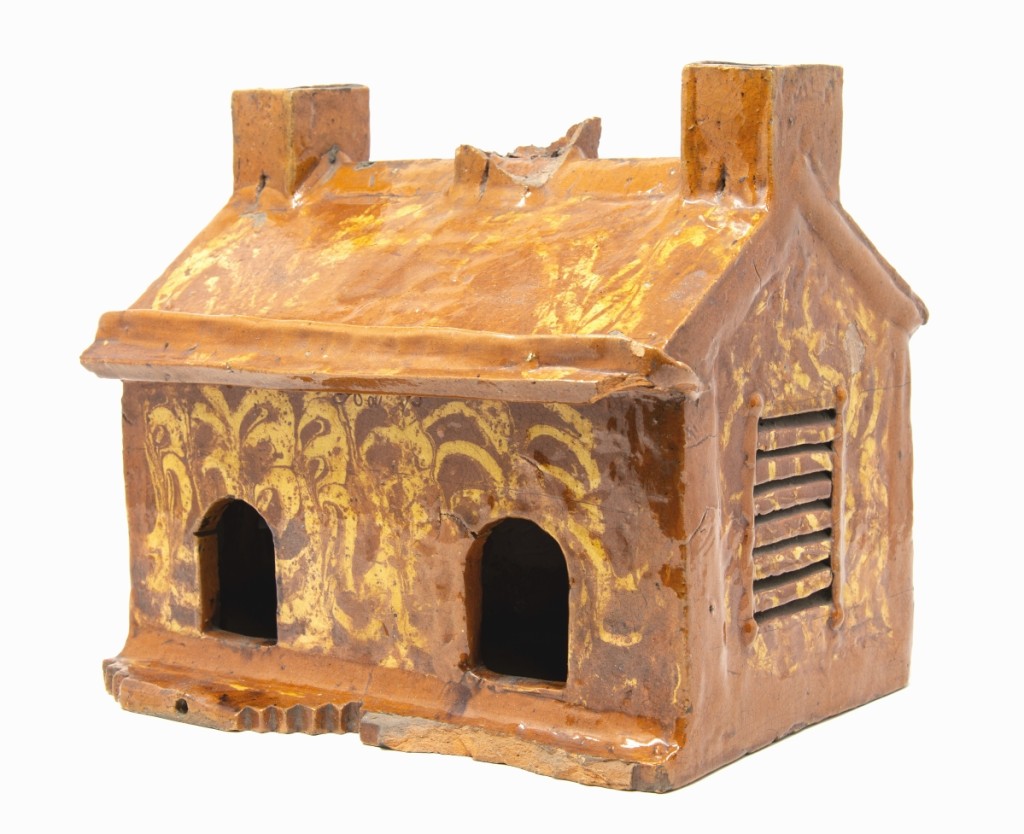
Nineteenth Century Pennsylvania slipware birdhouse. Collection of Chester County Historical Society.
The second-half of this exhibit is just as exciting as the first, drawing upon similar resources and shedding a new light on the type of wares that were already exhibited. The focus remains with the pottery made in Pennsylvania, but like the first exhibit, red earthenware will be displayed from other areas, demonstrating regional differences, but also how this is all tied together today with common clays found all over America, used to create low-fired red earthenware.
Aside from the museum objects and the wares on loan from private collections, the second half of the exhibit continues to recognize modern Pennsylvania potters. Pottery made by Ned Folz, Robesonia Pottery, Lester Breininger, Phil Richards, Tammy Zettlemoyer and Andrew Loercher is represented. A selection of potters tools is also on display.
Some of the more exciting pieces of pottery to see include additional examples of Pennsylvania sgraffito and figurals, outstanding slipware adorning plates and other forms, a painted whippet made by Samuel Bell (1811-1891) in Winchester, Va., dated “September 21, 1841,” an incredibly rare pig made by J. Eberly & Company in Strasburg, Va., as well as another Pennsylvania face jug. There is even a Pennsylvania tea canister, inscribed on the base, “Made by E. White March 22 1848 General Taylor Famous in the Battlefield of Mexico 1848,” along with a wonderful slip-decorated pitcher made in West Hartford, Conn., likely by Nathaniel Seymour (1763-1849), among dozens of other must-see pieces. The exhibit space ties it all in beautifully; no matter where you stand or look, you are completely surrounded in all directions with pottery representing nearly 340 years of production, dating from the Seventeenth to the Twenty-First Century.
An aspect of American red earthenware that I truly enjoy is the fact that no two surviving pieces are alike; every piece of pottery tells its own unique story, from its creation to how it was used and owned through the years. Most of these surviving wares originally existed for a household need, but at some point in the late Nineteenth through the mid-Twentieth Century, private collectors and museums began to notice these objects beyond a simple use, and instead recognized a time and place in American history that had passed, where this production was now identified as a work of art and a piece of living history. And the wares made in southeastern Pennsylvania are at the forefront of American red earthenware production, combining skill, color and decoration. This exhibit represents all of this and more, and it is certainly worth seeing for anyone interested in learning more about early domestic pottery production, the aesthetic appeal of utilitarian pottery, along with the history of the Pennsylvania Germans.
There’s no need to worry if you did not view the first half of the exhibit because the entire two-part show has been published in a catalog available in the visitor’s center at the Landis Valley Museum, as well as the museum’s website: https://www.landisvalleymuseum.org/.
















